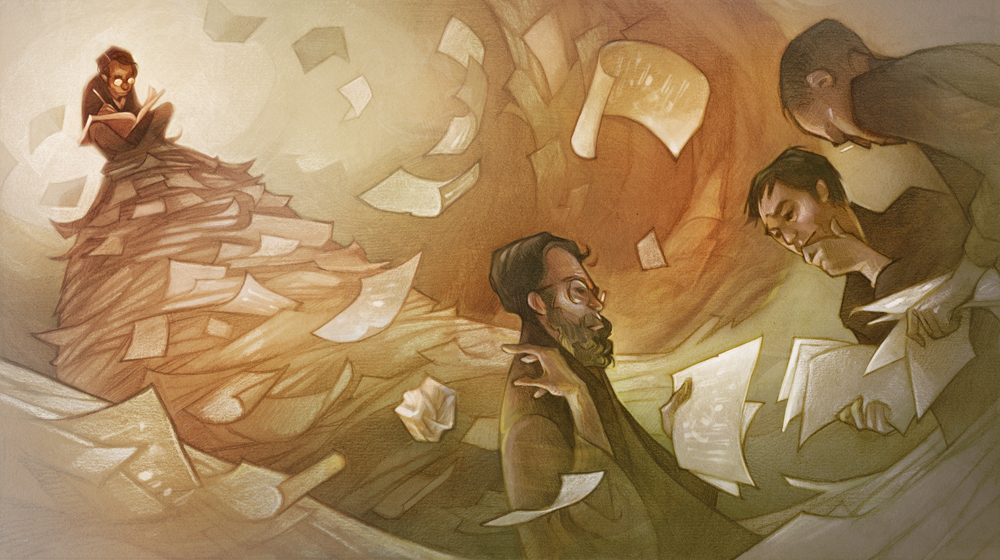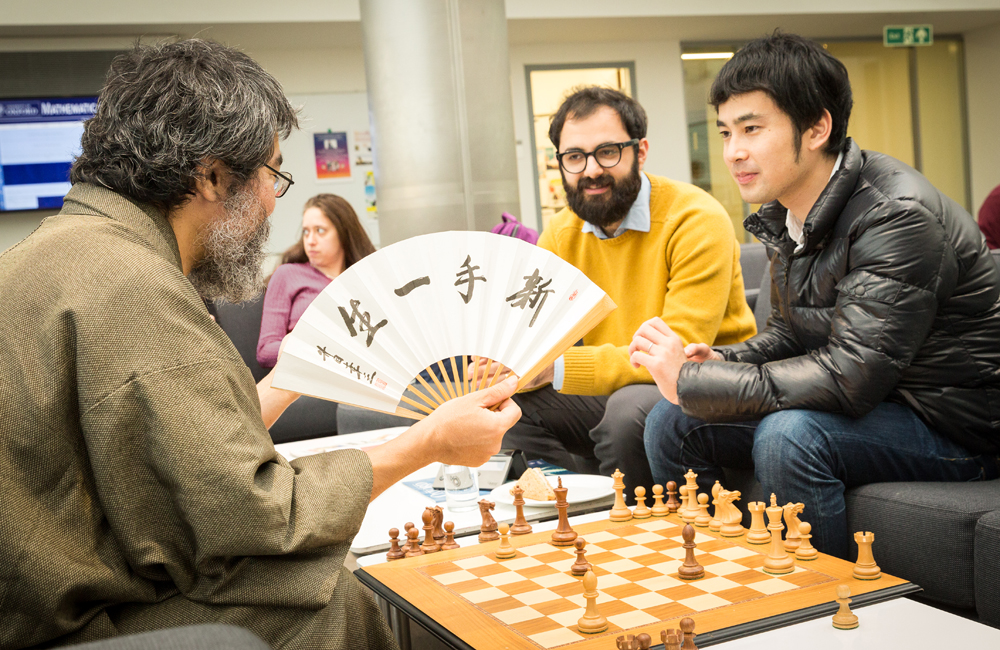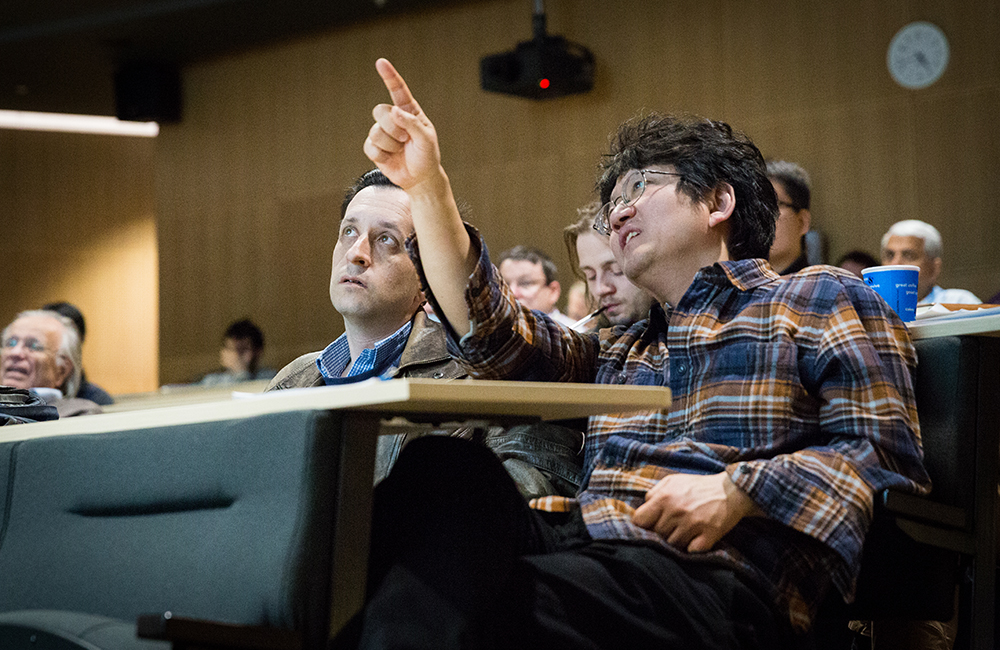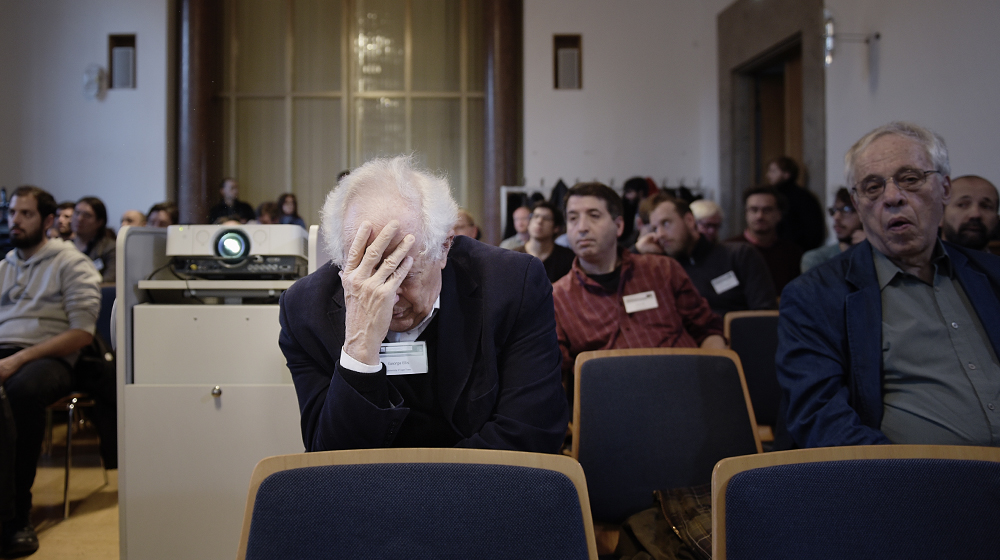Hope Rekindled for Perplexing Proof

Earlier this month the math world turned toward the University of Oxford, looking for signs of progress on a mystery that has gripped the community for three years.
The occasion was a conference on the work of Shinichi Mochizuki, a brilliant mathematician at Kyoto University who in August 2012 released four papers that were both difficult to understand and impossible to ignore. He called the work “inter-universal Teichmüller theory” (IUT theory) and explained that the papers contained a proof of the abc conjecture, one of the most spectacular unsolved problems in number theory.
Within days it was clear that Mochizuki’s potential proof presented a virtually unprecedented challenge to the mathematical community. Mochizuki had developed IUT theory over a period of nearly 20 years, working in isolation. As a mathematician with a track record of solving hard problems and a reputation for careful attention to detail, he had to be taken seriously. Yet his papers were nearly impossible to read. The papers, which ran to more than 500 pages, were written in a novel formalism and contained many new terms and definitions. Compounding the difficulty, Mochizuki turned down all invitations to lecture on his work outside of Japan. Most mathematicians who attempted to read the papers got nowhere and soon abandoned the effort.
For three years, the theory languished. Finally, this year, during the week of December 7, some of the most prominent mathematicians in the world gathered at the Clay Mathematical Institute at Oxford in the most significant attempt thus far to make sense of what Mochizuki had done. Minhyong Kim, a mathematician at Oxford and one of the three organizers of the conference, explains that the attention was overdue.
“People are getting impatient, including me, including [Mochizuki], and it feels like certain people in the mathematical community have a responsibility to do something about this,” Kim said. “We do owe it to ourselves and, personally as a friend, I feel like I owe it to Mochizuki as well.”
The conference featured three days of preliminary lectures and two days of talks on IUT theory, including a culminating lecture on the fourth paper, where the proof of abc is said to arise. Few entered the week expecting to leave with a complete understanding of Mochizuki’s work or a clear verdict on the proof. What they did hope to achieve was a sense of the strength of Mochizuki’s work. They wanted to be convinced that the proof contains powerful new ideas that would reward further exploration.
For the first three days, those hopes only grew.
A New Strategy
The abc conjecture describes the relationship between the three numbers in perhaps the simplest possible equation: a + b = c, for positive integers a, b and c. If those three numbers don’t have any factors in common apart from 1, then when the product of their distinct prime factors is raised to any fixed exponent larger than 1 (for example, exponent 1.001) the result is larger than c with only finitely many exceptions. (The number of exceptional triples a, b, c violating this condition depends on the chosen exponent.)
The conjecture cuts deep into number theory because it posits an unexpected relationship between addition and multiplication. Given three numbers, there’s no obvious reason why the prime factors of a and b would constrain the prime factors of c.
Until Mochizuki released his work, little progress had been made towards proving the abc conjecture since it was proposed in 1985. However, mathematicians understood early on that the conjecture was intertwined with other big problems in mathematics. For instance, a proof of the abc conjecture would improve on a landmark result in number theory. In 1983, Gerd Faltings, now a director of the Max Planck Institute for Mathematics in Bonn, Germany, proved the Mordell conjecture, which asserts that there are only finitely many rational solutions to certain types of algebraic equations, an advance for which he won the Fields Medal in 1986. Several years later Noam Elkies of Harvard University demonstrated that a proof of abc would make it possible to actually find those solutions.
“Faltings’ theorem was a great theorem, but it doesn’t give us any way to find the finite solutions,” Kim said, “so abc, if it’s proved in the right form, would give us a way to [improve] Faltings’ theorem.”
The abc conjecture is also equivalent to Szpiro’s conjecture, which was proposed by the French mathematician Lucien Szpiro in the 1980s. Whereas the abc conjecture describes an underlying mathematical phenomenon in terms of relationships between integers, Szpiro’s conjecture casts that same underlying relationship in terms of elliptic curves, which give a geometric form to the set of all solutions to a type of algebraic equation.

The translation from integers to elliptic curves is a common one in mathematics. It makes a conjecture more abstract and more complicated to state, but it also allows mathematicians to bring more techniques to bear on the problem. The strategy worked for Andrew Wiles when he proved Fermat’s Last Theorem in 1994. Rather than working with the famously simple but constraining formulation of the problem (which states that there is no solution in positive integers to the equation an +bn = cn for any integer value of n greater than 2), he translated it twice over: once into a statement about elliptic curves and then into a statement about another type of mathematical object called “Galois representations” of elliptic curves. In the land of Galois representations, he was able to generate a proof that he could apply to the original statement of the problem.
Mochizuki employed a similar strategy in his work on abc. Rather than proving abc directly, he set out to prove Szpiro’s conjecture. And to do so, he first encoded all the relevant information from Szpiro’s conjecture in terms of a new class of mathematical objects of his own invention called Frobenioids.
Before Mochizuki began working on IUT theory, he spent a long time developing a different type of mathematics in pursuit of an abc proof. He called that line of thought “Hodge-Arakelov theory of elliptic curves.” It ultimately proved inadequate to the task. But in the process of creating it, he developed the idea of the Frobenioid, which is an algebraic structure extracted from a geometric object.
To understand how this works, consider a square with the corners labeled A, B, C and D, with corner A in the lower right and corner B in the upper right. The square can be manipulated in a number of ways that preserve its physical location. For example, it can be rotated by 90 degrees counterclockwise, so that the arrangement of the labeled corners, starting from the lower right, ends up as (D, A, B, C). Or it can be rotated 180, 270 or 360 degrees, or flipped across either of its diagonals.
Each manipulation that preserves its physical location is called a symmetry of the square. All squares have eight such symmetries. To keep track of the different symmetries, mathematicians might impose an algebraic structure on the collection of all ways to label the corners. This structure is called a “group.” But as the group becomes freed from the geometric constraints of a square, it acquires new symmetries. No set of rigid motions will get you a square that can be labeled (A, C, B, D), since in the geometric square, A always has to be adjacent to B. Yet the labels in the group can be rearranged any way you want — 24 different ways in all.
Thus the algebraic group of the symmetries of the labels actually contains three times as much information as the geometric object that gave rise to it. For geometric objects more complicated than squares, such additional symmetries lead mathematicians to insights that are inaccessible if they use only the original geometry.
Frobenioids work in much the same way as the group described above. Instead of a square, they are an algebraic structure extracted from a special kind of elliptic curve. Just as in the example above, Frobenioids have symmetries beyond those arising from the original geometric object. Mochizuki expressed much of the data from Szpiro’s conjecture — which concerns elliptic curves — in terms of Frobenioids. Just as Wiles moved from Fermat’s Last Theorem to elliptic curves to Galois representations, Mochizuki worked his way from the abc conjecture to Szpiro’s conjecture to a problem involving Frobenioids, at which point he aimed to use the richer structure of Frobenioids to obtain a proof.
“From Mochizuki’s point of view, it’s all about looking for a more fundamental reality that lies behind the numbers,” Kim said. At each additional level of abstraction, previously hidden relationships come into view. “Many more things are related at an abstract level than they are at a concrete level,” he said.
In presentations at the end of the third day and first thing on the fourth day, Kiran Kedlaya, a number theorist at the University of California, San Diego, explained how Mochizuki intended to use Frobenioids in a proof of abc. His talks clarified a central concept in Mochizuki’s method and generated the most significant progress at the conference thus far. Faltings, who was Mochizuki’s doctoral adviser, wrote in an email that he found Kedlaya’s talks “inspiring.”
“Kedlaya’s talk was the mathematical high point of the meeting,” said Brian Conrad, a number theorist at Stanford University who attended the conference. “I wrote to a lot of people on Wednesday evening to say, wow, this thing came up in Kedlaya’s talk, so on Thursday we’re probably going to see something very interesting.”
It wasn’t to be.
‘Good Confusion’
The understanding that Mochizuki had recast abc in terms of Frobenioids was a surprising and intriguing development. By itself, though, it didn’t say much about what a final proof would look like.
Kedlaya’s exposition of Frobenioids had provided the assembled mathematicians with their first real sense of how Mochizuki’s techniques might circle back to the original formulation of Szpiro’s conjecture. The next step was the essential one — to show how the reformulation in terms of Frobenioids made it possible to bring genuinely new and powerful techniques to bear on a potential proof.

These techniques appear in Mochizuki’s four IUT theory papers, which were the subject of the last two days of the conference. The job of explaining those papers fell to Chung Pang Mok of Purdue University and Yuichiro Hoshi and Go Yamashita, both colleagues of Mochizuki’s at the Research Institute for Mathematical Sciences at Kyoto University. The three are among a small handful of people who have devoted intense effort to understanding Mochizuki’s IUT theory. By all accounts, their talks were impossible to follow.
Felipe Voloch, a number theorist at the University of Texas, Austin, attended the conference and posted updates throughout the five days on the social-media site Google Plus. Like Conrad, he went into the Thursday talks anticipating a breakthrough — one that never came. Later that fourth day he wrote, “At the afternoon tea break, everybody was confused. I asked many people and nobody had a clue.” Conrad echoes that sentiment, explaining that the talks were a blizzard of technical terms.
“The reason it fell apart is not meant as a reflection of anything with Mochizuki,” he said. “I mean, far too much information was thrown at the audience in far too little time. I spoke with every participant there who was not previously involved in this work and we were all completely and totally lost.”
The failure of the final talks to communicate how Frobenioids are used in IUT theory was partly to be expected, according to some participants.
“I think there was some hope that we’d be able to follow the trail all the way through to the end, but frankly the material gets substantially more difficult at that point,” Kedlaya said. “It’s not entirely the fault of the speakers who came after me.”
Kim thinks the trouble with the final talks is due in part to cultural differences. Yamashita and Hoshi are both Japanese; Kim explains that in Japan, mathematicians are more accustomed to dealing with a steady succession of technical definitions in presentations. “That was one situation where cultural differences really did play something of a role,” Kim said. “Many dense slides requiring a good deal of patience and focus — that kind of thing is more acceptable in Japan. People are more used to a dialectic, interactive style when you go to a lecture in the U.S.”
While the conference did not yield an unequivocal outcome (as few people really expected it to do), it did produce real, if incremental, progress. Kedlaya said afterward that he felt motivated to correspond with others who have read more of IUT theory and that he planned to attend the next conference on the topic, in July at Kyoto University.
“I’m not unhappy with the amount of progress that was made,” Kedlaya said. “We wanted more, but I think it’s worth the effort of this community to take at least one more run at this and see if we can get further.”
Others think the onus remains on Mochizuki to better explain his work. “[I] got the impression that unless Mochizuki himself writes a readable paper, the matter will not be resolved,” Faltings said by email.
Kim is less certain that this step will be necessary. After everyone had left Oxford, he reflected on the confusion the attendees took home with them. As he saw it, it was good confusion, the kind that develops when you’re on your way to learning something.
“Prior to the workshop I would say most people who came generally had no idea of what the author was attempting in the IUT papers,” he said. “Last week people were still confused, but they had a pretty concrete outline of what the author was trying to do. How does he do it? That was a vague question. Now there are many more questions, but they’re much more sophisticated kinds of questions.”
This article was reprinted on Wired.com.



